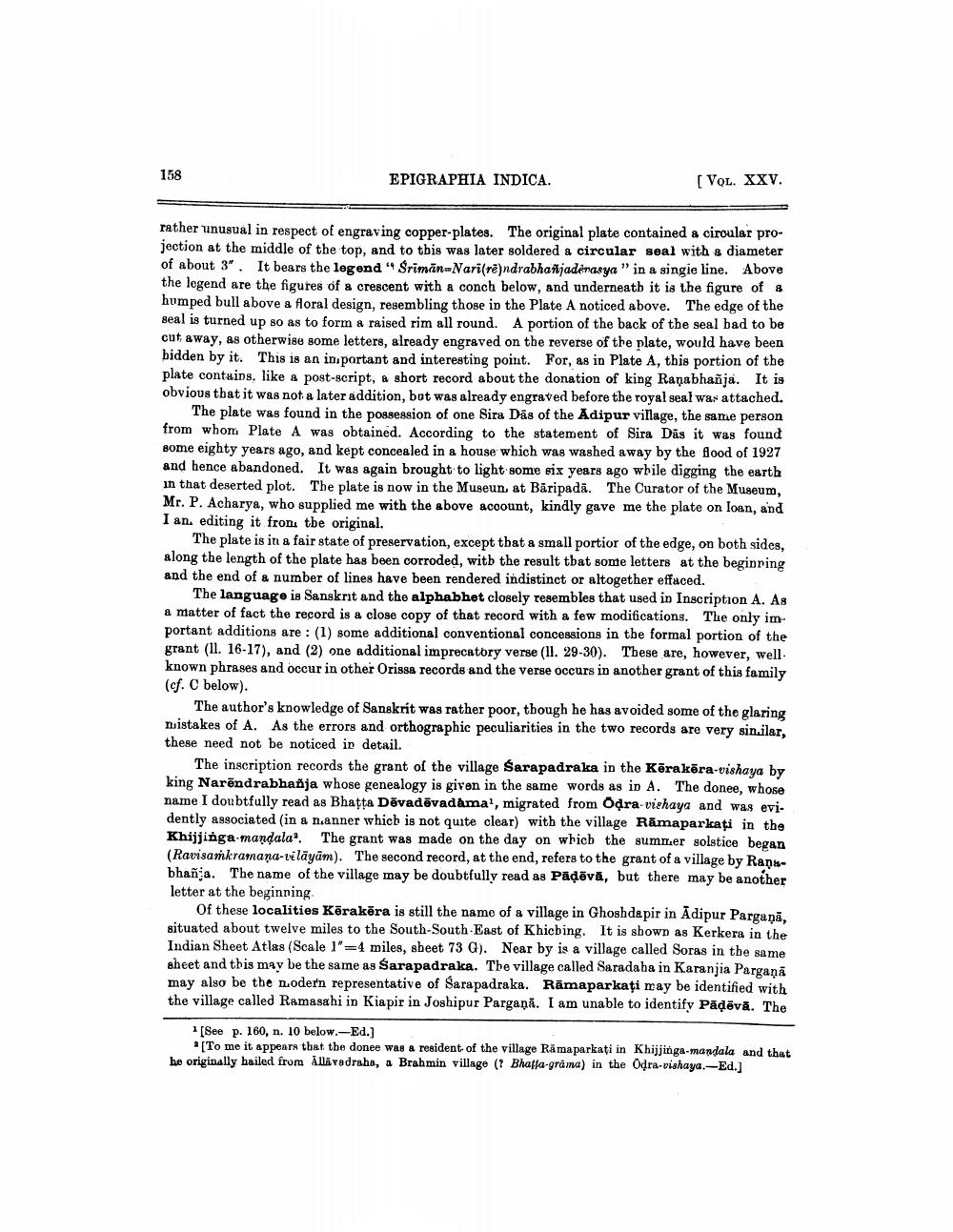________________
158
EPIGRAPHIA INDICA.
[Vol. xxv.
rather unusual in respect of engraving copper-plates. The original plate contained a circular projection at the middle of the top, and to this was later soldered a circular seal with a diameter of about 3". It bears the legend " Sriman=Nari(rē)ndrabhasjadenasya" in a singie line. Above the legend are the figures of a crescent with a conch below, and underneath it is the figure of a humped bull above a floral design, resembling those in the Plate A noticed above. The edge of the seal is turned up so as to form a raised rim all round. A portion of the back of the seal bad to be cut away, as otherwise some letters, already engraved on the reverse of the plate, would have been bidden by it. This is an inportant and interesting point. For, as in Plate A, this portion of the plate contains, like a post-script, a short record about the donation of king Ranabhanja. It is obvious that it was not a later addition, but was already engraved before the royal seal was attached.
The plate was found in the possession of one Sira Däs of the Adipur village, the same person from whom Plate A was obtained. According to the statement of Sira Das it was found some eighty years ago, and kept concealed in a house which was washed away by the flood of 1927 and hence abandoned. It was again brought to light some six years ago wbile digging the earth in that deserted plot. The plate is now in the Museun, at Bāripadā. The Curator of the Museum, Mr. P. Acharya, who supplied me with the above acoount, kindly gave me the plate on loan, and I an editing it froni tbe original.
The plate is in a fair state of preservation, except that a small portior of the edge, on both sides, along the length of the plate has been corroded, with the result tbat some letters at the beginring and the end of a number of lines have been rendered indistinct or altogether effaced.
The language is Sanskrit and the alphabhet closely resembles that used in Inscription A. As a matter of fact the record is a close copy of that record with a few modifications. The only im portant additions are: (1) some additional conventional concessions in the formal portion of the grant (ll. 16-17), and (2) one additional imprecatbry verse (1l. 29-30). These are, however, well. known phrases and occur in other Orissa records and the verse occurs in another grant of this family (cf. C below).
The author's knowledge of Sanskrit was rather poor, though he has avoided some of the glaring niistakes of A. As the errors and orthographic peculiarities in the two records are very sin.ilar, these need not be noticed in detail.
The inscription records the grant of the village Sarapadraka in the Kērakēra-vishaya by king Narēndrabhañja whose genealogy is given in the same words as in A. The donee, whose name I doubtfully read as Bhatta Dēvadēvadáma, migrated from Odra-viehaya and was evidently associated (in a n.anner which is not quite clear) with the village Rāmaparkati in the Khijjinga.mandala. The grant was made on the day on whicb the summer solstice began (Ravisamkramana-viläyām). The second record, at the end, refers to the grant of a village by Ranubhañja. The name of the village may be doubtfully read as Pādēvă, but there may be another letter at the beginning
Of these localities Kērakēra is still the name of a village in Ghoshdapir in Adipur Pargana, situated about twelve miles to the South-South-East of Khicbing. It is shown as Kerkers in the Indian Sheet Atlas (Scale l'=4 miles, sheet 73 G). Near by is a village called Soras in the same sheet and this may be the same as Sarapadraka. The village called Saradaha in Karanjia Pargana may also be the n.odern representative of Sarapadraka. Rāmaparkați may be identified with the village called Ramasahi in Kiapir in Joshipur Pargana. I am unable to identify Paļēvă. The
[See p. 160, n. 10 below.-Ed.]
*[To me it appears that the donee was a resident of the village Rāmaparkati in Khijjinga mandala and that he originally hailed from AMĀvadrahs, a Brahmin village (? Bhatta-grāma) in the Odra-vishaya.-Ed.]




